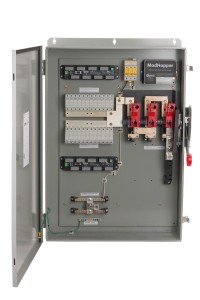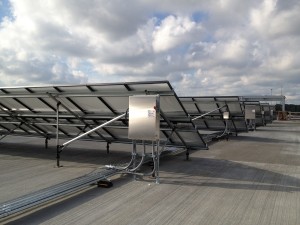The Evolution of the Combiner Box
Combiner boxes enhance safety and improve performance for solar installations.
By Brendan Foley
As the PV industry has grown and evolved, so too have many of the components found in solar installations. This is especially evident in the combiner box, which aggregates DC source circuits into a single circuit and provides overcurrent protection. A few years ago, combiner boxes were fundamentally the same; it was a simple box with fuse holders that combined string outputs circuits into a single circuit. As PV developers look to save costs and enhance safety, there are innovations in design, components and functionality that are transforming combiner boxes into a key PV system component t hat can help enhance safety and improve the overall performance of a PV system, while minimizing costs.
hat can help enhance safety and improve the overall performance of a PV system, while minimizing costs.
Fundamentally, solar combiner boxes aggregate many DC source circuits in a PV system and provide the overcurrent protection according to National Electrical Code (NEC) requirements. They contain input fuse holders for source protection, and the load sides of the fuse holders are connected together on a common bus that also has the output lugs, which allows multiple circuits to be combined into a single outgoing circuit.
Rules of the Road: Applicable Codes and Standards
With industry growth comes standardization and governance. As PV installations increased in the United States, the regulation of these installations expanded. For example, there was a change in the 2011 NEC for safety reasons, which now requires the addition of a switch within sight of fuse holders to isolate the fuses from any potential voltage source.
As any installer who accidentally opened a non-load break fuse holder under load would tell you, this was a much-needed change. The industry quickly adapted and added integral disconnects to standard combiner boxes, serving a number of functions. First, they open the circuit, allowing an operator to safely open a fuse holder for isolation or fuse servicing. Secondly, disconnects can function as a lock-out, tag-out (LOTO) device for operator safety. These are both valuable safety functions that typically were absent from earlier installations. As more utility-scale systems are commissioned, this safety feature becomes more important for operator and system safety.
In addition to the switch requirement, the 2011 NEC also added DC arc fault protection for the first time. Arc fault protection is not new — it has been a code requirement for residences since the 1999 edition of the code. The location of the arc fault protection is not yet identified in the code. For now, it will be up to the industry to determine the best location. The deciding factors will likely hinge on costs and functionality. There is interest in the industry to locate the arc fault circuit interrupter (AFCI) in the combiner box, balancing both cost and functionality.
Taking a look at the extremes helps to illustrate why the combiner box may be the most practical and cost-effective solution. Putting the AFCI in the central inverter can be accomplished cost-effectively; however, if there is an event that triggers the AFCI device, operators will need to determine where in the system the fault has occurred. In a large installation, this could take days.
On the other hand, if the AFCI is located at the module level, it could quickly help identify the location of the fault. On the downside, adding interrupters at each module could prove to be very costly for an industry that is driving toward grid parity.
There is a groundswell of opinion that the most economical and effective location for the AFCI is at the string level within the combiner box. This will likely be a cost savings over module-level solutions but will give an added level of fault isolation over central inverter solutions. With the new switched combiners, a means of opening the circuit is now present. Look for arc fault solutions within string combiners to be released over the next year.
Enhanced System Diagnostics Improve Performance
System diagnostics decisions must weigh the costs and benefits of measuring and addressing system performance issues. Whether caused by soiling, shading or module degradation, PV system performance decreases after initial installation. The degree of these performance issues can ultimately affect the payback period and financial viability of PV projects.
What is the optimum location for measuring and addressing these issues? Measuring at the central inverter is routinely done, but does it yield actionable information to address performance issues? Likewise, locating electronics in a distributed topology at the module level may yield excellent discrete performance data, but at what cost? The up-front hardware and installation costs could make many projects financially impractical.
A strong argument could be made that the combiner is the best location to measure and address PV system performance. While the data may not be as exhaustive as module-level diagnostics, it could yield actionable information that indicates systemic issues that lower the system performance and hurt the systems’ financial return. Look for additional and cost-effective system diagnostics in the short term.
Streamlined Installations
Lower installation costs are driving product innovations in combiner boxes as well. Quick-connect boxes, whips and pre-punched enclosures are some of the items that have been developed. These innovations have a higher up-front cost, so installers need to weigh the added material costs to the lower labor costs.
The next generation of combiner boxes is helping to enhance personnel safety, improve performance and provide robust system diagnostics — helping to propel the industry by supporting grid parity. Further, large manufacturers are bringing economies of scale and the research resources that will help advance the industry.
Brendan Foley is a product line manager at Eaton Corp. Eaton is a power management company that supplies complete solar PV electrical BOS solutions and provides support services. More information can be found at eaton.com/solar.






Comments are closed here.